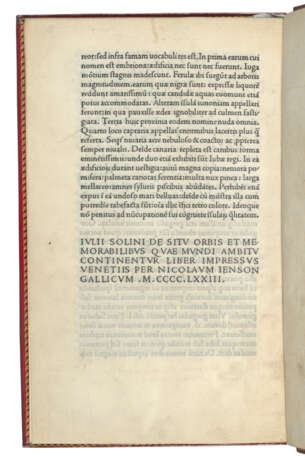ID 794487
Lot 119 | SOLINUS, Caius Julius (fl. 3rd century)
Estimate value
£ 120 000 – 180 000
De mirabilibus mundi. Venice: Nicolaus Jenson, 1473.
The Spencer copy of the first edition, printed on vellum, one of only three vellum copies known. Solinus’ On the Wonders of the World presents a chorographic account of many of the wonders of the ancient world, based largely upon Pliny’s Naturalis Historia and Mela’s De situ orbis. He discusses fabled wonders such as the Great Pyramid, the Temple of Artemis at Ephesus, and the Lighthouse of Alexandria and incorporates additional information regarding geological features, flora, fauna, and customs. As he progresses from Rome to Greece, the Middle East, and India, concluding with North Africa and the Canary Islands, Solinus displays a fascination with the mythical world, detailing locations such as the Gorgon Islands, on which he reports that monsters continue to survive, and creatures such as the Manticore, a blood-coloured monster with the face of a man and the body of a lion. Solinus further details marvels of the natural world more familiar to the modern reader, from the intelligence of elephants to the unique qualities of the Dead Sea. Notably, the text also contains the first known reference to the Mediterranean as ‘mare mediterraneum’ as opposed to ‘mare nostrum’ or ‘mare internum’.
Citations from it by authors such as Augustine, Isidore, and Bede attest to its influence from an early date, and the large number of surviving manuscripts from the 9th century and later (153, according to Mommsen, cf. Reynolds, Texts and Transmission) attest to its continued popularity. ‘[Solinus’] more striking and picturesque narratives are transferred almost in their entirety to medieval maps as late as the Hereford example’ (C.R. Beazeley, The Dawn of Modern Geography, I, 1987, pp.247-272). Arranged geographically, it derives largely from Pliny’s natural history and Mela’s geography. The popularity of the text was further amplified by the 15th-century Venetian practice of commissioning manuscripts by ancient authors; Solinus’ texts represents one of the earliest commissions in the collection of Bernardo Bembo (c.1457), testifying to its significance within the classical canon and its ongoing success in the age of early printing.
The other two vellum copies are in London at the British Library and in Padua at the Biblioteca Capitulare. HC 14877; BMC V, 173; CIBN S-302; Dibdin, Bibliotheca Spenceriana, II, p.359; Klebs 922.1; IGI 9084; Polain(B) 361; Van Praet, Catalogue des livres imprimés sur vélin ... dans des bibliothèques tant publiques que particulières, III, pp.4-5; Goff S-615.
Printed on vellum. Royal half-sheet quarto (260 x 167mm). 65 leaves (of 68, the 3 blank leaves replaced, probably at the time of binding by Kalthoeber). First text leaf illuminated by a contemporary artist in the Veneto with 7-line initial in purple-pink, blue and green with lighter penwork decoration, and two-sided border of flowers, leaves and gold discs and concentric penwork tendrils, 2-line initials alternating in red and blue over printed guide-letters. (Section of lower margin on 1⁄5 replaced [removing an armorial?], small marginal repair to 6⁄6.) 18th-century red straight-grained morocco gilt by Samuel Charles Kalthoeber with his ticket on front flyleaf, bound for Earl Spencer, with his arms in concentric panels, the innermost shaped around flower tool, spine richly gilt, gilt turn-ins, leather joints, marbled endpapers, gilt edges. Provenance: Charles duc de Rohan, Prince de Soubise (sale Paris, January 1789, lot 5850, 830FFr) – Count Karoly Imre Sandor de Reviczky (catalogue supplement, p.26) – George John, 2nd Earl Spencer (1758-1836, binding, red leather label, accession number 3482 on front flyleaf) – Manchester, John Rylands University Library (deaccession label, sale Sotheby's, 14 April 1988, lot 75) – [sold Christie’s, 29 November 2000, lot 31].
Special notice
No VAT on hammer price or buyer's premium.
| Address of auction |
CHRISTIE'S 8 King Street, St. James's SW1Y 6QT London United Kingdom | |
|---|---|---|
| Preview |
| |
| Phone | +44 (0)20 7839 9060 | |
| Buyer Premium | see on Website | |
| Conditions of purchase | Conditions of purchase |





